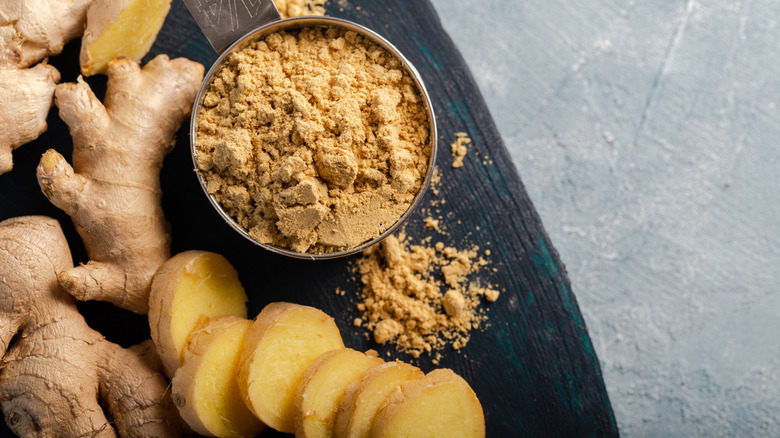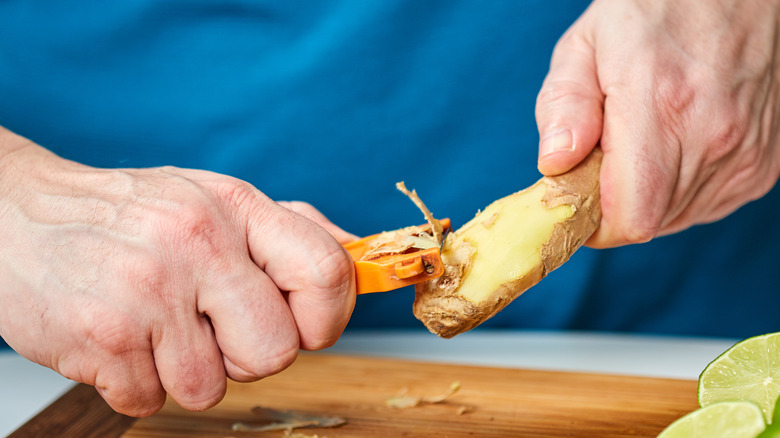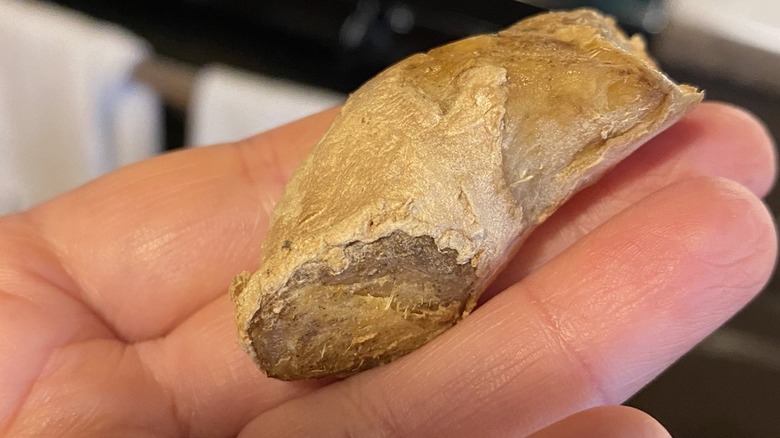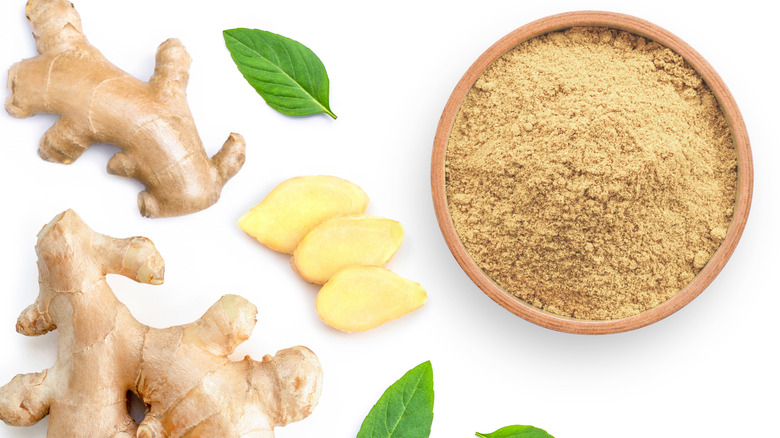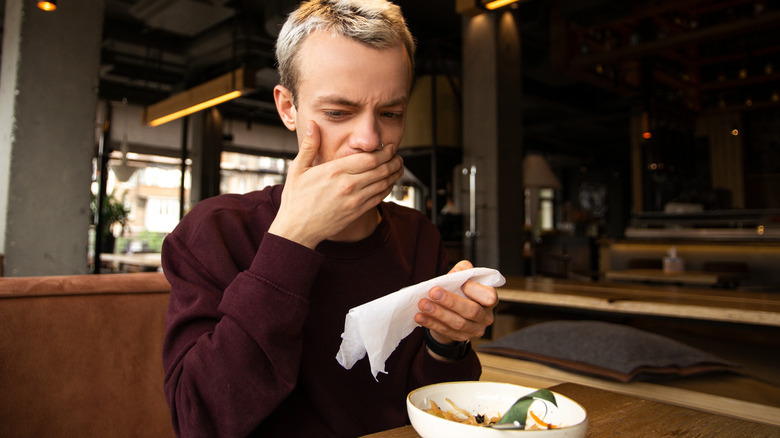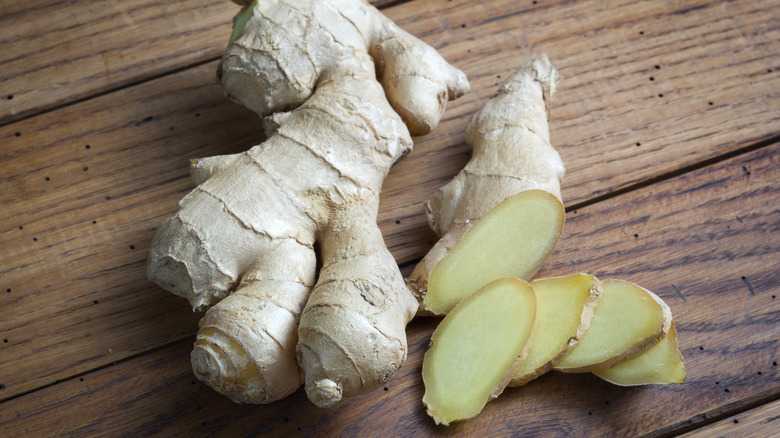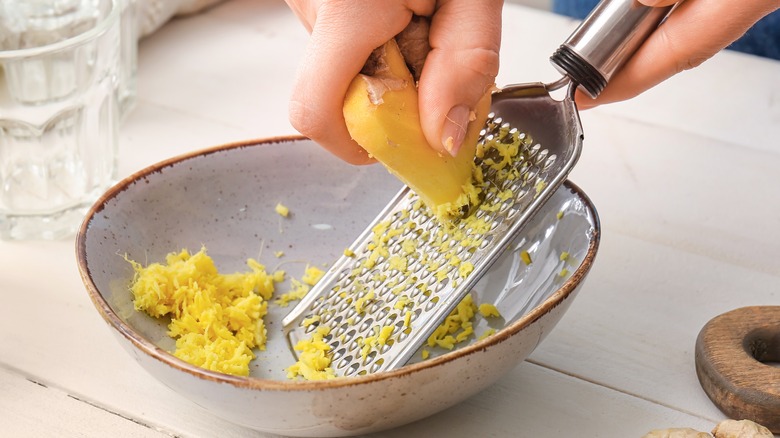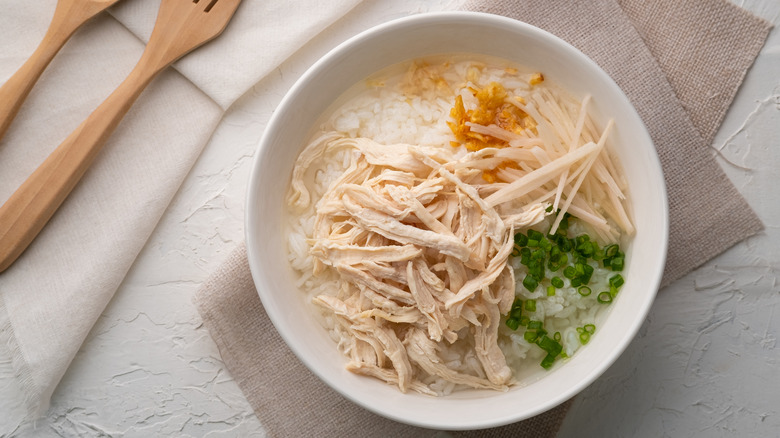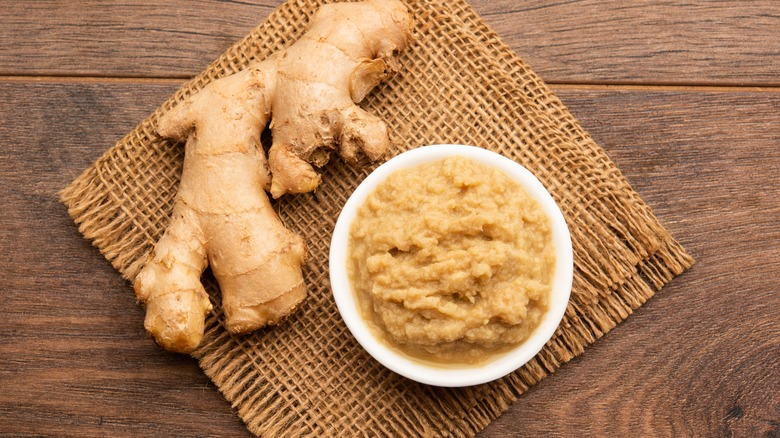8 Mistakes You're Probably Making When Cooking With Ginger
Whether you want to use more ginger in your cooking to reap its many health benefits or you just want to get more creative with spices and flavors, you're in for a treat once you learn how to work with the ingredient. This versatile root vegetable is used to make everything from gingerbread cookies and houses for the holidays to ginger beer.
But if you've grabbed fresh ginger root at the store and immediately start peeling and chopping it up to throw it into a dish, we urge you to pause. Ginger has an extremely unique flavor, shape, and texture, which can throw even seasoned cooks for a loop if they're new to cooking with it. It's best to learn a few tricks of the trade to avoid common mistakes people make, from not knowing how to avoid rotten ginger root to storing leftovers for waste prevention, in order to make the most of your fresh ginger.
Keep reading to identify these common mistakes and learn the best ways to prevent or fix them so that you can master the art of cooking with ginger.
1. Not peeling it properly
If you frequently cook with potatoes or carrots, you probably have a peeler tucked away in a kitchen drawer. The tool certainly comes in handy when removing tough outer peels from these types of veggie, but it's not necessarily the best tool for everything ... including ginger.
Despite being a root vegetable, ginger's peel is actually quite delicate, so it doesn't need much force to come off unlike a potato with tougher skin. In a video by popular TV chef Jamie Oliver, he demonstrates the best way of peeling ginger by using a spoon. He notes that the spoon helps shave off just the brown outer layer to prevent scraping away the actual ginger inside, which a peeler tends to do.
Now, if you aren't using the entire piece of ginger, you don't need to be as careful about scraping the peel off with a spoon. Instead, Oliver suggests using a knife to slice off the outer pieces. Then, let those pieces with the skin intact dry out and steep them for a cup of homemade ginger tea.
2. Not realizing it's gone bad
It can be easy to spot when many vegetables have gone bad, like slimy carrots and moldy, mushy cucumbers. It isn't always as obvious from the outside that ginger is not in good shape inside, making it easy to miss when you're shopping at the grocery store. And, if you're not yet savvy about using ginger, you might not even notice the warning signs after peeling and slicing the root.
Fresh ginger root lasts about one week at room temperature or one month in the refrigerator. If you've had it longer, there's a good chance it could be close to reaching the end of its lifespan, but you'll need to take a closer look to be sure. Once sliced, good ginger has an even yellow color throughout, while bad ginger forms a brown spot, often from its center.
If you want to check without slicing the ginger, examine the skin. Fresh ginger has a light yellowish-brown color and doesn't look or feel super dry or tough, nor wet or mushy. Ginger can occasionally sprout mold and get soft if it's been left in moist conditions for too long, but it usually tends to become extremely dry, hard, and dull when it's gone bad. Either way, it's a sign that it needs to be tossed.
3. Swapping fresh ginger for ground ginger
It's difficult to replace the aroma of fresh ginger. As soon as you slice or grate it, fresh ginger has a warm, somewhat spicy smell, which quickly permeates throughout any dish you use it in. If you're looking for a strong taste of ginger in your recipe, fresh ginger is usually the way to go.
For more peppery ginger flavors, ground ginger is a good substitute, especially if you only need a small amount and don't want to fuss with peeling and grating. It can also work well when you don't want chopped ginger in the dish, like in cookies or gingerbread. However, as soon as you open a container of ground ginger, you'll probably notice that it doesn't have the same aroma as the fresh version, which could be a bummer if you were really hoping for that tell-tale ginger flavor.
If you are going to use ground ginger, keep in mind that you usually don't need as much of it as you would the fresh stuff because it's a powder, so it's more concentrated. For best results, use about ¼ of a teaspoon of ground ginger to replace 1 teaspoon of fresh.
4. Adding too much ginger to a recipe
Because ginger has such a strong flavor, it's usually best to follow the a-little-bit-goes-a-long-way method when adding it to a dish. But if you don't use it regularly, you might have trouble judging how much you need to get enough flavor without going overboard. The problem with too much ginger is that it can quickly overpower a dish. It can be tough to judge when you first add it because, like many spices, its flavor changes and intensifies the longer it cooks.
The best technique is to start with just a little (maybe a teaspoon or so), stir it in, and let the dish cook for several minutes before taste-testing and adding more if needed. According to several Redditors who responded to a fellow user's ginger woes, they suggest mincing or finely grating the root to avoid overdoing it.
The good news is that if you end up adding too much ginger, you might still be able to save your dish. For starters, try adding a little more of your other spices to balance out the flavors or tossing in some sugar or honey, as sweetness can curb some of ginger's natural heat.
5. Not storing it properly
Since you typically don't need to use a whole ginger root in a recipe, you'll likely have a decent amount left over. Considering it only lasts about one week if you leave it in the pantry or sitting on the countertop, you might end up tossing what you have and buying new ginger every time you need it.
Instead, learn a few tricks for storing ginger longer. Jessica Hylton Leckie, a food blogger and owner of Jessica in the Kitchen, recommends not to store ginger in a bag if you're leaving it whole at room temperature, as bags can cause mold-producing moisture to accumulate (via Business Insider Reviews). Even more importantly, she notes that you can probably extend the shelf life by refrigerating the root in a resealable bag in your fridge's crisper drawer or by cutting it into small chunks and storing it in a resealable freezer-safe bag in the freezer.
Several Redditors use the freezer method, too. For example, one person always stores roots in a freezer bag and takes it out to grate some ginger as needed. A user in another Reddit thread also mentions that it's safe to peel ginger before you freeze it, too, making it ready to go when you need to grate a small amount for a dish.
6. Skipping the right grating or cutting technique
Knowing the right mincing, grating, and slicing techniques for ginger can help you get uniform cuts for cooking. Some chefs recommend first squaring up the ginger by cutting off any knobby edges that might get in the way. Then, peel the outer skin before using the smallest holes of a cheese grater to grate the ginger with gentle pressure. Use your fingers to remove the flesh from inside the grater, which is what you'll want to use for cooking. Not a fan of peeling ginger? Some people prefer to grate ginger with its skin on, which is also perfectly acceptable.
To mince ginger, you'll want to slice the root in half to give you a flat surface to work with. Then, lay the flat side down and use your knife to cut the ginger into thin strips before turning them and chopping them into smaller pieces, continuing the process until you have uniform minced cuts. You can also slice ginger by making thin, uniform cuts after peeling it.
But when should you use each method? Slicing is usually best in dishes where you want to strain out the ginger, like broths, soups, or teas, while minced or grated ginger works best in dishes where you want ginger flavor without finding chunks of the root in your meal, like in sauces and stir-fries.
7. Adding ginger at the wrong time
If you regularly cook, you probably know that many flavors intensify with time. For example, if you make your own spaghetti sauce, you might leave it simmering over low heat for several hours to really bring out all the elements you've added. Similarly, ginger's flavor and strength can change as you cook it, which may affect when you want to add it to your dish.
Ginger actually contains a compound called gingerol that gets stronger in aroma as it cooks, because heat changes its chemical composition. That's why over time, ginger's spiciness can become more intense, but its flavor actually becomes a little subtler. Therefore, if you're looking for unmistakable ginger flavor, you might want to wait until the last few minutes of the cooking process to toss it in. But, if you want that peppery spice that ginger brings to a dish after cooking for a while, remember to add it toward the beginning to give it plenty of time to cook.
8. Always grabbing fresh ginger instead of ginger paste
While we love fresh ginger for soups, broths, teas, or even brightening up a stir-fry or ramen recipe, we also know how time-saving it can be to not have to peel and chop it if we're in a pinch and need dinner on the table soon. That's where ginger paste comes in. And, no, you shouldn't feel ashamed for using it instead of the fresh stuff sometimes.
In fact, ginger paste is a popular staple for many home cooks when fresh ginger just isn't as convenient to use. For example, it comes in handy when ginger is out of season and not as readily available. Ginger paste can be an excellent substitution in curries, dipping sauces, or a ginger salad dressing.
If possible, go the homemade route. In one Reddit thread, several commenters mention that store-bought ginger paste can vary a lot in quality depending on the brand and doesn't usually have the same strong aroma and flavor as fresh ginger. However, homemade ginger paste allows you to control the ingredients and preparation to ensure that it's fresh and high-quality. To make your own, you need fresh sliced ginger, salt, and vegetable oil. Blend the ingredients together until they form a paste. Then, you can pour the paste into an ice cube tray to store in your freezer for single servings of ginger paste as needed.
